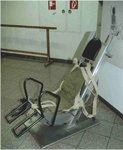I have looked through some of the previous threads and seen that there have been the best/worst aircraft of WW2 which got me thinking a little bit.
I seem to recall reading that the Bristol Beaufighter was considered to be a death trap of an aircraft, as it was very difficult to bail out of.
Also the P39 Airacobra with the side door exit in stead of the canopy would be difficult to get out of when in flight due to the fact that there would be considerable slipstream acting on the doors. The pilots would need muscles like Popeye!
Were any other WW2 aircraft considered to be death traps by the poor sods who had to fly them?
I seem to recall reading that the Bristol Beaufighter was considered to be a death trap of an aircraft, as it was very difficult to bail out of.
Also the P39 Airacobra with the side door exit in stead of the canopy would be difficult to get out of when in flight due to the fact that there would be considerable slipstream acting on the doors. The pilots would need muscles like Popeye!
Were any other WW2 aircraft considered to be death traps by the poor sods who had to fly them?

